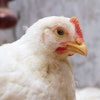
Promotion of contract egg production and an excellent transportation of feedstuffs for broiler production caused a shift of egg production to the Southwest during the ‘60s. Total eggs in the South exceeded the Central states. Layer numbers in the South Atlantic region were 64 million, 48 million in the Pacific region, and 44 million in the East Central region.
Egg production became seriously in surplus in California and the Southeast. Eggs had to be hauled great distances to sell them. By 1973, California was 40%+ surplus. A major shift back to feed supplies and markets began in the 1980s and continues today.
Beginnings of egg production
In the 1900s, probably 90% of commercial eggs were produced on general farms as a sideline or by-product. The flocks were generally 100-300 hens with free range feeding on waste grain and weed seeds and insects. The eggs sold were regarded as pin money for the housewife.
Eggs were often sold through the general store and to traveling hucksters who would go from farm to farm. The huckster or grocer graded and packed the eggs and shipped them to a packer commission house where they were candled, repacked and sent by carloads to city markets. Due to unknown quality, prices at the local level were necessarily low.
Labor requirements for layers
With the small farm flocks of 200-400 birds, there was practically no labor assigned for their care. In some cases, there were incubation needs and proper egg storage. The next step was for flocks of 1,000-10,000 birds. Then additional labor was needed—commercial layers 60-75 per month with room and board. The managers of the larger farms received $1,000-1,500 salaries. Bonuses were added to the manager for each year for hatching, raising, egg production, etc. A common bonus was $25 if the flock averaged over 144 eggs per year. In 1925, a hen required 2.5 hours per year, allowing a person to care for 1,165 birds. In 1953, records showed that Southern California farms recorded 1.3 hours per hen. At this rate, a person could handle 2,240 birds including egg processing, or 3,236 not processing the eggs.
In 1958, in San Diego County, labor dropped to $8 an hour per hen with 31% of the time for egg processing. Thus, 3,640 hours per person processing and 5,275 hours not egg processing.
In 1962, Orange County showed labor dropping to 56 hours per hen—5,200 birds with egg processing, and 7,100 without egg processing. Today, one person can manage 100,000 layers with automated feeding systems, belt egg collection, manure removal and manure belts.
Disease and control
There were many drugs and remedies to treat sick birds:
• Calomel—used for a variety of
ailments.
• Cayenne—as a liver stimulant.
• Catechu—to treat severe diarrhea.
• Castor oil—to treat diarrhea.
• Epsom salts—for liver trouble and
diarrhea.
• Cottonseed oil and olive oil—used when hens were bound; for diarrhea; and external and internal use in dressing sores.
Disease control
Through the years, many chronic health problems have been virtually eliminated for egg rearing and laying farms. Coccidiosis has been eliminated by rearing in cages and houses. Pullorum was eradicated by testing and eliminating positive reactors.
Vaccines for diseases came on the scene in the 1930s and ‘40s. Fowl Pox Laryngotracheitis and Newcastle were some vaccines first developed. Today there are vaccines and bacteria for many poultry diseases. They can be injected, given by water, or in aerosols.
Marek’s disease hit California farms in the 1930s and caused 30% mortality. Farms ran from 24-45% mortality. From 1945 to 1965, death rates dropped to 15% as vaccines and management improved. Marek’s vaccine was a real technology breakthrough.
Disease imposes higher levels of mortality. Its contribution to sub-optimal egg production is difficult to document, though it causes major disruptions of the industry’s way of doing business.
Three examples of costly outbreaks are: outbreak of Newcastle Disease in 1971-73; Avian influenza in Pennsylvania in 1983-84; and the continuing problem of Salmonella enteriditis in Pennsylvania.
Morbidity and loss of production due to depopulation caused huge economic losses. Some producers chose not to resume production after depopulation. Direct costs of the program, including indemnification were in excess of $120 million dollars. Indirect costs of the avian influenza outbreak were estimated at $349 million dollars.
Diseases and developments of treatments
Many individuals and firms began offering various treatments for poultry in the 1920s.
George H. Lee in Omaha, Neb., advertised Gernozone extensively. He later added wormers and louse killers. Walko tablets were advertised by Walker in Waterloo, Iowa. Dr. LuGear wore a surgeon’s robe and offered “tonics.” Blatchford Calf Meal Co. of Waukegan, Ill., imported a “secret formula” from England. It attained nation-wide distribution.
Pratt of Pennsylvania and Hess & Clark of Ohio featured broader lines, advertised extensively and employed salesmen. I.D. Russell of Arkansas began his business by mixing a louse powder. He sold it first from a horse and buggy and became so successful, he had a big business in Kansas City.
Dr. J.E. Salsbury, a practicing veterinarian in Charles City, Iowa, began to sell phenols in the late 1920s. He advertised modestly and offered diagnostic services. His business grew as he added salesmen and employed technical people. He built buildings for laboratories and manufacturing product. He had schools to educate customers about products and technology. In 1968, Dr. Salsbury was elected to the Poultry Industry Hall of Fame.
Genetics of the laying hen
Two events contributed materially to the advancement of poultry breeding from an art to a science. They were the discovery of the Mendelian principle of inheritance and the trap nest by which individual production could be measured and the ancestry be traced.
Dr. Don Warren lists these as the real pioneers in Leghorn breeding—he includes C.H. Wychoff; Park’s Farm; Hollywood Farms; Hanson Farm; Beall Farm; Ghoslly Farm; Dryden Farm and Kimler Farm—all pre-1930. Post-1930 breeders included Highline Farms (H.A. Wallace); Monroe Babcock; DeKalb; D.M. Shaver and Art Heisdirf. A list of New England brown egg breeders include Hasco Orchard Poultry Farms; EB Permentor; J.J. Warren; C.N. Hardy; Robert Cobb; Hubbard Farms and G.B. Treadwell.
Hatcheries
In 1926, California had 262 commercial hatcheries with a capacity of 7.8 million eggs. During the 1930s, there were more than 10,000 hatcheries in the U.S. By 1988, the number shrank to 372. Today there are fewer than a dozen major hatcheries and another dozen smaller ones serving the egg industry.
In the early years, hundreds of chicks were delivered by the U.S. Post Office. As farms grew larger, hatcheries were required to hatch chicks in groups of 1,000 and more. During the 1950s and ‘60s, flocks of 10,000 and up to 50,000 were common. Today, deliveries of 100,000 to 300,000 chicks are made with no more than a 4-5 day spread. The logistics of this process of assembling and delivering became rather complicated for both the hatchery and the poultryman. In 1994, U.S. hatcheries produced 379 million straight-run chicks—an average of 15.5 million pullets a week.
Feeds and feeding
Early poultry flocks had free range and were often fed root vegetables and leafy greens. Some producers even provided roots in the winter. Early mixed ration blended grain included wheat bran and middlings, meat scraps and gluten feed.
In the 1940s, complete all-mash rations became standard; as the farmer got larger, bulk feeding reduced labor costs.
Today, egg producers monitor bodyweights and house temperatures and formulate rations to exacting needs. Bodyweights are managed to minimize maintenance needs. Egg size relative to egg price is optimized by temperature and dietary adjustments.
Technological changes
Cages were experimented with in the mid-1920s. Originally they were built of wood with wire floors for single birds. Emphasis was on high rates of lay with intensive culling and annual replacement of flocks. In the late 1940s, 100% replacement was accomplished by weekly culling in single cages and year-round scheduling of replacement pullets.
Cages became popular to improve sanitation practices. Reducing contact with feces reduced parasite and health problems. This resulted (caging) in better flock mutation, washes could be handled effectively, and eggs could be clean and safer for the consumer.
Cages helped lead to in-line complexes with environmental controls, decked cages, automated manure removal, after a feed mill, an egg room and seven-day-per-week packing. Pullets are raised separately.
Technology changes
In the 1940s and 1950s, egg producers spent half their time cleaning, sizing and packing eggs. Today, we talk of blood spot detection, imaging depiction of eggs, automatic stain and dirt removal, and automated pallet and rack loading equipment. This equipment will likely continue to improve.
These technology changes have led to farms producing eggs from over 5 million in 1900 to less than 1,000 in 1995.
Egg consumption
In 1930, the per capita U.S. egg consumption was 231 eggs. It remained at 300-325 eggs until 1940. During WWII, consumption increased as there were meat shortages and government programs were designed to stimulate egg production. Consumption trended downward until it stabilized at 234 to 240 eggs in 1989 to 1995. The negative impact of cholesterol in eggs led to much of the decline.
In 1989, the Egg Nutrition Council challenged the USDA on the supposed cholesterol levels. Tests showed there was 22% less than previously thought. This information began a reversal of a drop in consumption. A considerable amount of eggs were consumed—baking and dried eggs and other foods.
The egg industry is blessed with a highly regarded product in terms of nutrition. It is a very versatile basic food commodity. Manufacturers are producing products with lower or no cholesterol. Ultra-pasteurization techniques offer longer and safer shelf life for egg products. These new egg products help eggs break from their almost complete association with breakfast—a meal that continues to decline.















